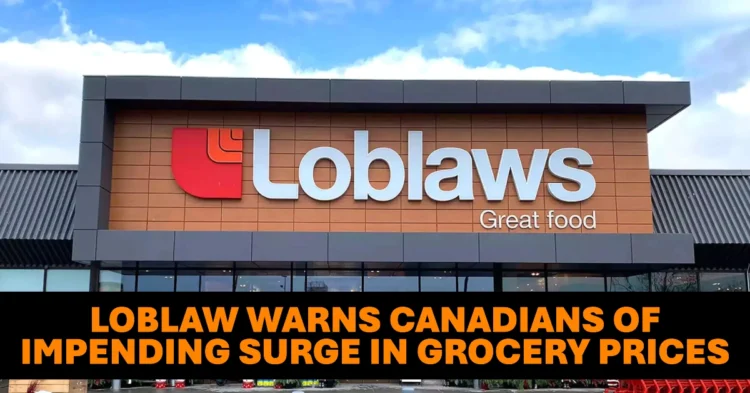As much as Canadians would love a break at the checkout counter, the reality is disappointing: grocery prices are set to rise again. Loblaw Companies Limited, one of the country’s largest grocery retailers, has released its May 27 food inflation report, warning that thousands of everyday products will see price increases.
The cause? A mix of ongoing U.S. tariffs, the global trade landscape, and Canada’s shifting response to protect consumers.
Table of Contents
Tariffs Are Driving Up Food Prices in Canadian Stores
Loblaw, which operates major chains like Loblaws, No Frills, and Real Canadian Superstore, points the finger directly at U.S.-imposed tariffs. These tariffs apply to a wide range of goods imported into Canada — many of which are daily staples for Canadian households.
From fresh produce to pasta and coffee, as well as personal care items like soap and shampoo, roughly 6,000 products — half of them food-related — are expected to see price increases. This is no small dent in the average grocery bill, considering the typical grocery store may carry over 80,000 different items.
What Saved Canadians From Even Higher Prices?
Loblaw does acknowledge that it could have been worse. The Canadian government recently introduced a six-month reprieve on certain tariffs applied to ingredients used in domestic food production. These so-called “indirect tariffs” were temporarily lifted to help avoid a dramatic spike in prices.
This move affects imported goods that aren’t sold directly to consumers, like chocolate chips or peanuts, which are widely used in “Made in Canada” products. By sparing these ingredients from tariffs, only the finished U.S. products continue to be taxed, offering some cushion to shoppers.
Grocers Are Fighting Back — But It’s Complicated
Loblaw says it’s doing what it can to protect consumers from the full brunt of these price hikes. Grocers are:
- Sourcing products from new countries
- Helping customers make better-informed choices through labeling
- Encouraging manufacturers to adapt supply chains to avoid U.S. tariffs
These measures are aimed at reducing reliance on U.S. imports and keeping costs under control — but not every product has an easy or affordable alternative.
What You’ll See in Stores Over the Coming Months
The warning signs aren’t new. Back in March, when tensions between Canada and the U.S. flared into a full-blown trade conflict, Loblaw signaled that higher prices were coming — just not immediately. At the time, inventories were still stocked with untaxed products. Now, those supplies are dwindling, and the impact is starting to show.
Earlier this month, Loblaw CEO Per Bank shared on LinkedIn that Canadian store aisles are bracing for a “large wave of tariff-related increases”.
While some global trade relationships are improving, the U.S.-Canada tension remains. As a result, Canadians should expect higher grocery bills through the summer and possibly beyond.
Canadians Could Cash In on $500 Million Loblaws Bread Price-Fixing Lawsuit
Credit One Bank Lawsuit Settlement Important Dates, Who Qualifies, and How to File a Claim
Cash App Settlement: How to Track Your $2,500 Payout and What to Expect
Meta Begins $90M Payouts in Facebook Lawsuit Over ‘Like’ Button Privacy Issue
Verizon Class Action Settlement: How to Claim Your Share of the $100 Million Refund for Hidden Fees
Judge Orders Air Canada to Pay $10 Million in Passenger Class Action Settlement
The Bottom Line: Expect to Pay More, But Not Across the Board
While the food inflation outlook isn’t entirely grim thanks to government intervention and retailer action, the fact remains: thousands of products are still becoming more expensive. The next time you’re scanning prices at your local store, you’ll likely notice the difference — especially on items still heavily sourced from the U.S.
Staying informed and being flexible with brands and product choices may be the best tools shoppers have right now to combat the impact of this ongoing trade turbulence.

